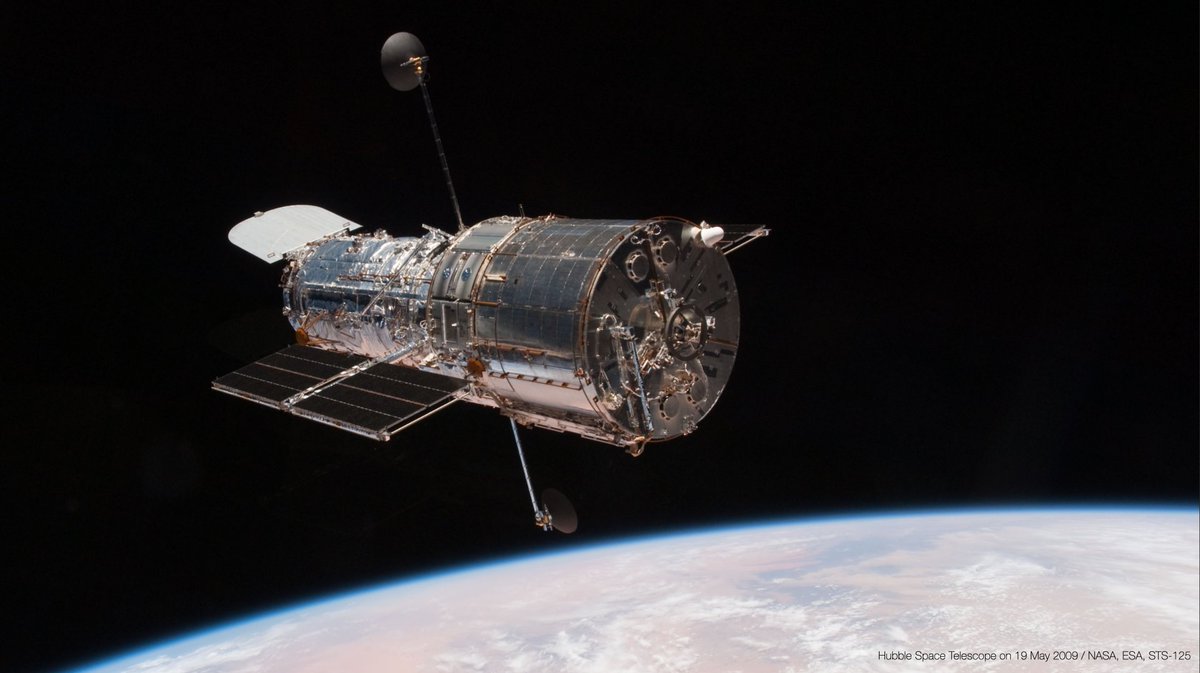
A few hours from now, #JWST will make its Mid-Course Correction 2 (MCC-2) burn, injecting it into its operational orbit around the Sun-Earth L2 point, ~1.5 million kilometres away.
What, why, how, when?!
A thread.
1/
What, why, how, when?!
A thread.
1/
First, a reminder: #JWST was launched on #Ariane5 #VA256 from Europe's spaceport in French Guiana on 25 December 2021. The #Ariane5 put it on a near-perfect trajectory towards L2 & two subsequent JWST Mid-Course Corrections have tweaked that.
2/
2/
But why such a long journey to a place that's about four times further away from Earth than the Moon?
By contrast, the Hubble Space Telescope is in a low Earth orbit ~535km above the surface, making it accessible to several servicing missions over the past 31 years.
3/
By contrast, the Hubble Space Telescope is in a low Earth orbit ~535km above the surface, making it accessible to several servicing missions over the past 31 years.
3/

The problem with being close to Earth is that Earth is warm & thus heats Hubble. And because Hubble orbits Earth every ~97 minutes, it spends roughly half the time in the dark & half being heated by the Sun.
This is not what we need for #JWST.
4/
This is not what we need for #JWST.
4/
As #JWST operates in the infrared, we want the telescope & instruments to be very cold (i.e. at -233ºC / 40K or so) to avoid them emitting light at the same wavelengths we're trying to detect from our targets.
So we need to be far from Earth & block the Sun.
5/
So we need to be far from Earth & block the Sun.
5/
At the same time, you don't want to be *too* far from Earth, because the greater the distance, the lower the data transmission rates.
And the amazing science instruments on #JWST can generate a lot of data very quickly, so being too far away would limit the science.
6/
And the amazing science instruments on #JWST can generate a lot of data very quickly, so being too far away would limit the science.
6/
So, the question is, can we find a place not too far away where both the Sun & Earth will always be on one side of a giant parasol, allowing the other side where the telescope & instruments are to get very, very cold?
The answer is "yes" & that's L2.
7/
The answer is "yes" & that's L2.
7/

So what is L2? And for that matter, what is L1 & are there any other Ln places?
The answers lie with Joseph-Louis Lagrange, an Italian-born, naturalised French astronomer & mathematician.
8/
The answers lie with Joseph-Louis Lagrange, an Italian-born, naturalised French astronomer & mathematician.
8/

Among many other important contributions, Lagrange studied planetary orbits, & found some interesting solutions to the so-called "three-body problem".
This aims to describe the motion of three objects moving around each other under gravity, a notoriously tricky problem.
9/
This aims to describe the motion of three objects moving around each other under gravity, a notoriously tricky problem.
9/
What Lagrange found was a family of of solutions for the situation where two of the objects (e.g. the Sun & Earth) are massive, but the third (e.g. #JWST) is much lighter.
That is, the gravity of the Sun & Earth influence the situation, but that of #JWST is negligible.
10/
That is, the gravity of the Sun & Earth influence the situation, but that of #JWST is negligible.
10/
In more detail, Lagrange found five points in such a system where the interplay between the gravity of the two large bodies & their centripetal forces as they orbit creates points of equilibrium where the third object can sit without much orbital correction needed.
11/
11/
The not-to-scale diagram below shows where these points are relatively to the Sun & Earth.
L1, L2, & L3 are along a straight line joining the Sun & Earth; L4 & L5 are at the vertices of equilateral triangles with the Sun & Earth at the other two vertices.
12/
L1, L2, & L3 are along a straight line joining the Sun & Earth; L4 & L5 are at the vertices of equilateral triangles with the Sun & Earth at the other two vertices.
12/

The arrows in the diagram above show how the potential at each L-point works. L4 & L5 can be thought of as large flat hilltops & combining gravity, centripetal force, & Coriolis force in a rotating system, these are stable: they're hard to fall off.
13/
physics.stackexchange.com/questions/3609…
13/
physics.stackexchange.com/questions/3609…
[Thanks to @NMK_ZeroG for catching my schoolboy error there, where I previously described L4 & L5 as valleys – I'd completely forgotten about the Coriolis forces 😱
Apologies for deleting & reposting.]
Apologies for deleting & reposting.]
@NMK_ZeroG Many asteroids have collected in the L4 & L5 points of the Sun-Jupiter system: those that lead Jupiter by 60º are called "Greeks"; those that trail, "Trojans".
Generically, such L4/L5 objects in any system are called trojans & a couple of Earth trojans are known.
14/
Generically, such L4/L5 objects in any system are called trojans & a couple of Earth trojans are known.
14/

@NMK_ZeroG Looking back at the Lagrange point diagram in tweet 12 though, you'll see that L1, L2, & L3 are different.
Instead of flat hilltops with downward slopes in all directions, these are better thought of as "saddles".
Image: Wikipedia/BLW
15/
Instead of flat hilltops with downward slopes in all directions, these are better thought of as "saddles".
Image: Wikipedia/BLW
15/

@NMK_ZeroG That is, at each of L1, L2, & L3, there are upward "hills" in the direction along the orbit, but downward "slopes" towards & away from Earth.
As a result, these are not stable equilibrium points like L4 & L5: it's possible to fall off them, like sliding off a saddle.
16/
As a result, these are not stable equilibrium points like L4 & L5: it's possible to fall off them, like sliding off a saddle.
16/
@NMK_ZeroG Without going to deeply into the maths, it's possible to have an intuitive understanding of why this is so.
First, consider Earth, orbiting the Sun in a 365.25 Earth days, one Earth year.
Now think about the other planets & how long they take to orbit the Sun.
17/
First, consider Earth, orbiting the Sun in a 365.25 Earth days, one Earth year.
Now think about the other planets & how long they take to orbit the Sun.
17/
Sorry: the full 42 tweet thread got broken here. Let’s see if I can glue it back together 🤞
https://twitter.com/markmccaughrean/status/1485659601672491010
• • •
Missing some Tweet in this thread? You can try to
force a refresh






